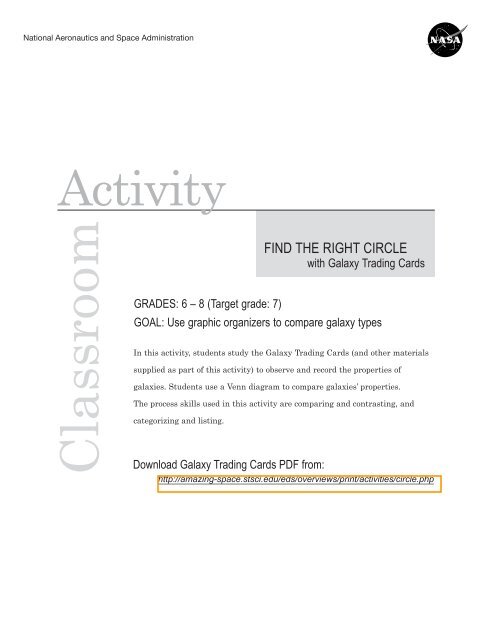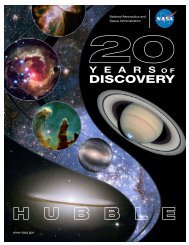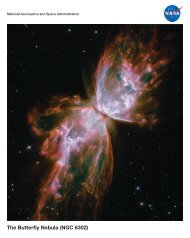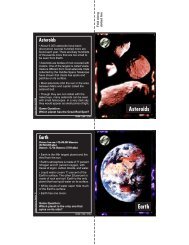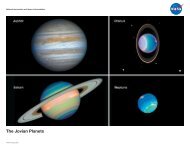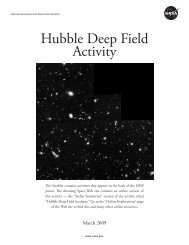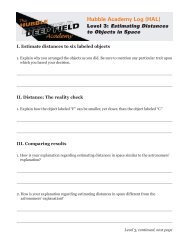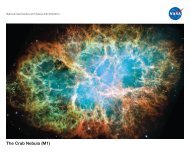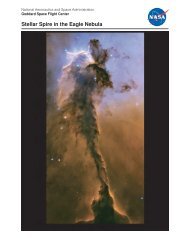Classroom Activity: Find the Right Circle - Amazing Space - STScI
Classroom Activity: Find the Right Circle - Amazing Space - STScI
Classroom Activity: Find the Right Circle - Amazing Space - STScI
- No tags were found...
Create successful ePaper yourself
Turn your PDF publications into a flip-book with our unique Google optimized e-Paper software.
National Aeronautics and <strong>Space</strong> Administration<br />
<strong>Classroom</strong> <strong>Activity</strong><br />
<strong>Activity</strong><br />
<strong>Classroom</strong><br />
GRADES: 6 – 8 (Target grade: 7)<br />
FIND THE RIGHT CIRCLE<br />
with Galaxy Trading Cards<br />
GOAL: Use graphic organizers to compare galaxy types<br />
In this activity, students study <strong>the</strong> Galaxy Trading Cards (and o<strong>the</strong>r materials<br />
supplied as part of this activity) to observe and record <strong>the</strong> properties of<br />
galaxies. Students use a Venn diagram to compare galaxies’ properties.<br />
The process skills used in this activity are comparing and contrasting, and<br />
categorizing and listing.<br />
Download Galaxy Trading Cards PDF from:<br />
http://amazing-space.stsci.edu/eds/overviews/print/activities/circle.php
Contents<br />
C L A S S R O O M A C T I V I T Y<br />
3 Purpose<br />
3 Materials<br />
3 Instructions for <strong>the</strong> Teacher<br />
7 Learning Outcomes Mapped to Education Standards<br />
8 Prerequisites and Misconceptions<br />
10 Answer Key to Student <strong>Activity</strong> Sheet A<br />
11 Answer Key to Student <strong>Activity</strong> Sheet B<br />
12 New Vocabulary<br />
14 Student <strong>Activity</strong> Sheet A<br />
15 Student <strong>Activity</strong> Sheet B<br />
17 Images of Spiral, Elliptical, and Irregular Galaxies<br />
S U P P L E M E N T A L M A T E R I A L S A V A I L A B L E O N L I N E<br />
Download <strong>the</strong> following supplemental materials from<br />
http://amazing-space.stsci.edu/eds/overviews/print/activities/circle.php<br />
R E Q U I R E D<br />
•Galaxy Trading Cards (PDF)<br />
O P T I O N A L (specific to this activity)<br />
•Teacher ’s Science Background: Galaxy Q&As (PDF)<br />
•Teacher ’s Science Background: Constellation Q&As (PDF)<br />
•Student’s Background Reading: About Galaxies (PDF)<br />
•Student’s Background Reading: About Constellations (PDF)<br />
O P T I O N A L (general)<br />
•Glossary of Astronomy Terms Related to Galaxies (PDF)
<strong>Find</strong> <strong>the</strong> <strong>Right</strong> <strong>Circle</strong><br />
Comparing Galaxies Using Graphic Organizers<br />
P u r p o s e<br />
The purpose of <strong>the</strong> activity is to observe and record <strong>the</strong> properties of galaxies by studying <strong>the</strong><br />
Galaxy Trading Cards and o<strong>the</strong>r pictures and readings supplied as part of this activity. Students use<br />
a Venn diagram to compare galaxies, based on observed properties. The process skills used in this<br />
activity are comparing and contrasting, and categorizing and listing. This activity can be used to<br />
teach students about galaxies, or as an assessment, following a study of galaxy types.<br />
M a t e r i a l s<br />
• Selected Galaxy Trading Cards;<br />
card set available as a separate PDF<br />
• <strong>Activity</strong> Sheet A: Compare/Contrast<br />
Chart: Comparison of Galaxies, p. 14<br />
• <strong>Activity</strong> Sheet B: Venn Diagram:<br />
Comparison of Spiral and Elliptical<br />
Galaxies, pages 15 – 16<br />
• Additional images of spiral, elliptical, and<br />
irregular galaxies, pages 17 – 20<br />
• Supplemental student reading: “About<br />
Galaxies,” available as a separate PDF<br />
E x e c u t i o n T i m e<br />
60 – 70 minutes<br />
Instructions<br />
for <strong>the</strong> Teacher<br />
P r e p a r a t i o n<br />
Make a copy of each of <strong>the</strong> activity sheets<br />
found at <strong>the</strong> end of this lesson (“Comparison<br />
of Galaxies” chart and <strong>the</strong> Venn diagram) for<br />
each student. Depending on whe<strong>the</strong>r this<br />
activity is performed at <strong>the</strong> beginning or at<br />
<strong>the</strong> end of a unit on galaxies, students may<br />
also need <strong>the</strong> supplemental student reading<br />
(“About Galaxies,” a separate PDF), which<br />
summarizes <strong>the</strong> characteristics of each<br />
galaxy type.<br />
For each student or group of students, make<br />
a set of Galaxy Trading Cards. To make <strong>the</strong><br />
cards: Download <strong>the</strong> trading cards PDF file<br />
(… continued on page )
NASA / <strong>Amazing</strong> <strong>Space</strong> <strong>Classroom</strong> <strong>Activity</strong><br />
(Teacher’s Instructions, continued from page …)<br />
from http://amazing-space.stsci.edu/eds/<br />
overviews/print/activities/circle.php. Print<br />
<strong>the</strong> PDF on heavy paper or card stock. Fold<br />
younger students may need to read <strong>the</strong>se<br />
sections to <strong>the</strong> class, choosing what is necessary<br />
and appropriate for <strong>the</strong> younger group.<br />
each card on <strong>the</strong> dotted line to form a front<br />
and back. Glue, tape, or laminate <strong>the</strong> fronts<br />
and backs toge<strong>the</strong>r and trim <strong>the</strong> cards.<br />
Prepare copies of <strong>the</strong> additional galaxy<br />
images found at <strong>the</strong> end of this activity for<br />
each student or group of students, or make<br />
color overhead images of <strong>the</strong>se galaxies.<br />
S t r a t e g i e s<br />
This activity is a good follow-up to <strong>the</strong><br />
activity, “Group <strong>the</strong> Galaxies.” In both activities,<br />
students read <strong>the</strong> information on <strong>the</strong><br />
Galaxy Trading Cards and use it to help<br />
determine <strong>the</strong> characteristics of elliptical,<br />
spiral, and irregular galaxies.<br />
S c i e n c e B a c k g r o u n d<br />
To use this activity, teachers should be<br />
familiar with <strong>the</strong> material covered in<br />
questions 1, 2, and 5 – 8 of <strong>the</strong> teacher’s<br />
science background document, “Galaxy<br />
Q&As,” supplied as a separate PDF. Older<br />
students can also use this material to do<br />
research on related topics, to read as a<br />
follow-up to <strong>the</strong> activity, or to review <strong>the</strong><br />
major concepts, prior to a class discussion.<br />
S t u d e n t R e a d i n g<br />
Sections in <strong>the</strong> supplemental student<br />
reading (“About Galaxies”), titled “The Milky<br />
Way,” “Shape,” and “Classification,” provide<br />
students with some background information<br />
about galaxies and can be used before<br />
and/or during <strong>the</strong> activity. Teachers of<br />
Students can work toge<strong>the</strong>r as a class or<br />
break up into small groups to complete <strong>the</strong><br />
first graphic organizer, <strong>the</strong> “Comparison of<br />
Galaxies” chart. If you decide that students<br />
should work toge<strong>the</strong>r as a class, <strong>the</strong>n post a<br />
large chart in <strong>the</strong> front of <strong>the</strong> room to record<br />
<strong>the</strong>ir answers.<br />
Astronomers classify galaxies into three<br />
groups, however, <strong>the</strong> predictable shapes of<br />
spiral and elliptical galaxies are compared<br />
before <strong>the</strong> irregular galaxies are addressed.<br />
P r o c e d u r e<br />
Make sure that students know what a<br />
galaxy is by asking <strong>the</strong>m if <strong>the</strong>y can describe<br />
<strong>the</strong> characteristics of <strong>the</strong> Milky Way galaxy.<br />
If students have recently completed <strong>the</strong><br />
(… continued on page )
NASA / <strong>Amazing</strong> <strong>Space</strong> <strong>Classroom</strong> <strong>Activity</strong><br />
(Teacher’s Instructions, continued from page …)<br />
“Group <strong>the</strong> Galaxies” activity, ask <strong>the</strong>m to<br />
describe a galaxy.<br />
Completing <strong>Activity</strong> Sheet A: “Compare/<br />
Contrast Chart: Comparison of Galaxies”<br />
•Provide students with several pictures<br />
from <strong>the</strong> Galaxy Trading Cards. Some of<br />
<strong>the</strong> pictures should be spiral galaxies (such<br />
as NGC 4321, NGC 4156 and NGC 7217)<br />
and some of elliptical galaxies (such as<br />
NGC 4881 and NGC 3377). Be sure that<br />
students understand <strong>the</strong>y have two classes<br />
of galaxies.<br />
•Ask students to examine <strong>the</strong> galaxy<br />
cards and look for differences and similarities<br />
between <strong>the</strong> spiral and <strong>the</strong> elliptical<br />
galaxies. Students should record <strong>the</strong> characteristics<br />
of <strong>the</strong>se two classes of galaxies in<br />
<strong>the</strong> appropriate column on <strong>the</strong> “Comparison<br />
of Galaxies” chart. If students are just beginning<br />
<strong>the</strong>ir study of galaxies, <strong>the</strong>n provide<br />
<strong>the</strong>m with <strong>the</strong> information about galaxies<br />
found in <strong>the</strong> student reading to help <strong>the</strong>m<br />
complete <strong>the</strong> chart.<br />
•Once students have finished this section<br />
of <strong>the</strong>ir charts, provide <strong>the</strong>m with ano<strong>the</strong>r<br />
image of a spiral and an elliptical galaxy.<br />
Don’t tell <strong>the</strong>m which galaxy is which<br />
type. Then ask <strong>the</strong>m to decide whe<strong>the</strong>r<br />
<strong>the</strong> galaxies fit into <strong>the</strong> spiral or elliptical<br />
column on <strong>the</strong>ir compare/contrast charts.<br />
•Next, introduce <strong>the</strong> idea of irregular<br />
galaxies by giving <strong>the</strong>m images of irregular<br />
galaxies from <strong>the</strong> Galaxy Trading Cards<br />
(such as: NGC 5253, NGC 4038 and 4039,<br />
and ESO 350-G040). Ask <strong>the</strong>m, as a class,<br />
to try to classify <strong>the</strong>se galaxies. Students<br />
should realize that <strong>the</strong>se new galaxies are<br />
nei<strong>the</strong>r spiral, nor elliptical and belong to<br />
<strong>the</strong> third column, called irregulars. Ask<br />
students to write down <strong>the</strong> characteristics of<br />
irregular galaxies in <strong>the</strong> third column.<br />
•Once students have completed <strong>the</strong> whole<br />
chart, give <strong>the</strong>m o<strong>the</strong>r galaxies to classify<br />
based on <strong>the</strong> information on <strong>the</strong>ir compare/<br />
contrast charts.<br />
•If students have been working independently<br />
or in small groups, teachers may<br />
want to check <strong>the</strong>ir charts to make sure <strong>the</strong>y<br />
have included all <strong>the</strong> characteristics in <strong>the</strong><br />
correct column before proceeding.<br />
Completing <strong>Activity</strong> Sheet B:<br />
“Venn Diagram: Comparison of Spiral and<br />
Elliptical Galaxies”<br />
•To emphasize <strong>the</strong> similarities as well as<br />
<strong>the</strong> differences between <strong>the</strong> three classes<br />
of galaxies, provide students with <strong>Activity</strong><br />
(… continued on page )
NASA / <strong>Amazing</strong> <strong>Space</strong> <strong>Classroom</strong> <strong>Activity</strong><br />
(Teacher’s Instructions, continued from page …)<br />
Sheet B, which contains a two-circle Venn<br />
diagram and questions about irregular<br />
galaxies. A Venn diagram consists of two or<br />
more overlapping circles. It is often used in<br />
ma<strong>the</strong>matics to show relationships between<br />
sets. In o<strong>the</strong>r applications, Venn diagrams<br />
are useful for examining similarities and<br />
differences in <strong>the</strong> characteristics of objects or<br />
ideas. In this application, <strong>the</strong> circles represent<br />
elliptical and spiral galaxy types. Each<br />
circle contains information on a particular<br />
galaxy type. Where <strong>the</strong> two circles overlap,<br />
<strong>the</strong> characteristics are common to both<br />
types.<br />
•Tell students to fill in <strong>the</strong> Venn diagram<br />
with <strong>the</strong> aid of <strong>the</strong>ir comparison chart<br />
common to both elliptical and spiral galaxies<br />
belongs in <strong>the</strong> central region where <strong>the</strong> two<br />
circles overlap. O<strong>the</strong>rwise, characteristics<br />
common to spiral galaxies belong in <strong>the</strong><br />
spiral circle and those common to elliptical<br />
galaxies belong in <strong>the</strong> elliptical circle.<br />
•Once <strong>the</strong> Venn diagram is complete, ask<br />
students to answer <strong>the</strong> questions on irregular<br />
galaxies that appear on <strong>the</strong> first page of<br />
Student <strong>Activity</strong> Sheet B.<br />
E X T E N S I O N<br />
Students can use <strong>the</strong>ir Venn diagram to help<br />
<strong>the</strong>m write an essay comparing <strong>the</strong> three<br />
types of galaxies. <br />
(<strong>Activity</strong> Sheet A). A characteristic that is
NASA / <strong>Amazing</strong> <strong>Space</strong> <strong>Classroom</strong> <strong>Activity</strong><br />
Learning Outcomes Mapped to Education Standards<br />
Learning outcomes<br />
from<br />
<strong>the</strong> activity<br />
Using galaxy image<br />
data, students will be<br />
able to identify <strong>the</strong><br />
characteristics of spiral,<br />
elliptical, and irregular<br />
galaxies, in order to<br />
compare and contrast<br />
galaxy properties.<br />
Alignment with<br />
National<br />
Science Standards<br />
Science as Inquiry,<br />
Content Standard A<br />
(pg. 145, Grades 5-8)<br />
As a result of activities<br />
in grades 5-8, all<br />
students should develop<br />
abilities necessary to<br />
do scientific inquiry,<br />
i.e., use appropriate<br />
tools and techniques<br />
to ga<strong>the</strong>r, analyze and<br />
interpret data.<br />
Alignment with<br />
McREL<br />
Standards<br />
Life Skills: Thinking<br />
and Reasoning,<br />
Standard 3<br />
[Student] effectively uses<br />
mental processes that<br />
are based on identifying<br />
similarities and<br />
differences.<br />
Benchmark 3, Level<br />
III (Grades 6-8)<br />
[Student] selects criteria<br />
or rules for category<br />
membership that are<br />
relevant and important.<br />
Benchmark 6, Level<br />
III (Grades 6-8)<br />
[Student] creates a<br />
table to compare specific<br />
abstract and concrete<br />
features of two items.
NASA / <strong>Amazing</strong> <strong>Space</strong> <strong>Classroom</strong> <strong>Activity</strong><br />
Prerequisites<br />
and Misconceptions<br />
Below are some common misconceptions<br />
students may have about galaxies. Teachers<br />
should be aware of <strong>the</strong>se misconceptions and<br />
determine whe<strong>the</strong>r <strong>the</strong>ir students harbor<br />
any of <strong>the</strong>m. Teachers need to determine<br />
<strong>the</strong> knowledge base of <strong>the</strong>ir students, and<br />
use <strong>the</strong> information presented below and<br />
elsewhere in this guide to help students<br />
learn what <strong>the</strong>y need to know in order to<br />
successfully complete <strong>the</strong>se activities. At<br />
<strong>the</strong> very least, students should be aware<br />
that galaxies are groups of stars that don’t<br />
necessarily look <strong>the</strong> same. They should<br />
also be familiar with <strong>the</strong> way astronomers<br />
identify galaxies.<br />
Students may have misconceptions regarding<br />
<strong>the</strong> makeup, distances, and sizes of galaxies.<br />
They may not understand that galaxies are<br />
groups of stars — not just single stars —<br />
that come in a variety of shapes, sizes, and<br />
colors. Students should be aware that galaxies<br />
are vast collections of stars, gas, and dust<br />
held toge<strong>the</strong>r by gravity, but <strong>the</strong>y don’t all<br />
look <strong>the</strong> same. The shapes of galaxies vary<br />
— some are elliptical, o<strong>the</strong>rs are spiral, and<br />
still o<strong>the</strong>rs have no definite shape. Galaxies<br />
aren’t even <strong>the</strong> same size — small galaxies<br />
may have only a few million stars in <strong>the</strong>m,<br />
while large galaxies can have several trillion<br />
stars. Vast distances separate <strong>the</strong>se large<br />
numbers of stars.<br />
Galaxies can be several thousand to<br />
hundreds of thousands of light-years across.<br />
(A light-year is <strong>the</strong> distance traveled by light<br />
in a full year, equal to some 10 trillion<br />
kilometers, or about 6 trillion miles.)<br />
Students may be aware of <strong>the</strong> size of <strong>the</strong><br />
solar system and think it is very large.<br />
Light, however, can travel from <strong>the</strong> Sun to<br />
Earth in about eight minutes, while light<br />
from <strong>the</strong> star closest to <strong>the</strong> Sun takes about<br />
four years to arrive at Earth.<br />
Students may have misconceptions regarding<br />
<strong>the</strong> stars <strong>the</strong>y see at night. All <strong>the</strong> stars in<br />
<strong>the</strong> night sky are part of <strong>the</strong> same galaxy<br />
— <strong>the</strong> Milky Way. Many students may think<br />
that all stars are exactly <strong>the</strong> same. Stars,<br />
however, vary in brightness, color, mass,<br />
temperature, and age. The Milky Way is<br />
home to <strong>the</strong> Sun, <strong>the</strong> Earth, <strong>the</strong> entire solar<br />
system, billions of stars, and most o<strong>the</strong>r<br />
celestial bodies visible with <strong>the</strong> unaided eye.<br />
O<strong>the</strong>r galaxies appear as fuzzy spots in <strong>the</strong><br />
(… continued on page )
NASA / <strong>Amazing</strong> <strong>Space</strong> <strong>Classroom</strong> <strong>Activity</strong><br />
(Prerequisites, continued from page …)<br />
sky when viewed with <strong>the</strong> unaided eye and<br />
even amateur telescopes.<br />
Students should be aware of <strong>the</strong> significance<br />
of galaxy names. For example, NGC 5253<br />
refers to <strong>the</strong> 5,253rd entry in The New<br />
General Catalogue of Nebulae and Clusters<br />
of Stars, which was compiled by John L.E.<br />
Dreyer in <strong>the</strong> nineteenth century as a<br />
comprehensive list of nebulae (cloudy patches)<br />
and star clusters. This catalog remains <strong>the</strong><br />
standard reference used by astronomers<br />
<strong>the</strong> world over. When first observed, many<br />
galaxies were classified as nebulae because<br />
astronomers didn’t know what <strong>the</strong>y were.<br />
Galaxies whose names begin with “ESO”<br />
are part of an archive of observations made<br />
by telescopes that are managed fully or in<br />
part by <strong>the</strong> European Sou<strong>the</strong>rn Observatory.<br />
Since <strong>the</strong> Hubble <strong>Space</strong> Telescope (HST)<br />
is a joint venture between NASA and <strong>the</strong><br />
European <strong>Space</strong> Agency, ESO numbers are<br />
used to designate HST observations.
NASA / <strong>Amazing</strong> <strong>Space</strong> <strong>Classroom</strong> <strong>Activity</strong><br />
Answer Key to Student <strong>Activity</strong> Sheet A<br />
N o t e : This chart presents a complete comparison of <strong>the</strong> three types of galaxies. The Galaxy Trading<br />
Cards do not provide all of <strong>the</strong> information contained in this chart. Students may need to search <strong>the</strong> student<br />
readings to find <strong>the</strong> information.<br />
<br />
<br />
<br />
<br />
<br />
<br />
<br />
<br />
<br />
<br />
<br />
<br />
<br />
<br />
<br />
<br />
<br />
<br />
<br />
<br />
<br />
<br />
<br />
<br />
<br />
<br />
<br />
<br />
<br />
<br />
<br />
<br />
<br />
<br />
<br />
<br />
<br />
<br />
<br />
<br />
<br />
<br />
10
NASA / <strong>Amazing</strong> <strong>Space</strong> <strong>Classroom</strong> <strong>Activity</strong><br />
Answer Key to Student <strong>Activity</strong> Sheet B<br />
N o t e : This chart presents a complete comparison of <strong>the</strong> three types of galaxies. The Galaxy Trading<br />
Cards do not provide all of <strong>the</strong> information contained in this chart. Students may need to search <strong>the</strong><br />
student readings to find <strong>the</strong> information.<br />
Venn Diagram: Comparison of Spiral and Elliptical Galaxies<br />
Q1. Explain why irregular galaxies are not part of this comparison.<br />
A: Irregular galaxies don’t have a predictable shape or structure.<br />
Q2. What features of irregular galaxies are also common to both spiral and elliptical galaxies<br />
A: Like spirals and ellipticals, irregular galaxies are huge. They contain stars, gas, and dust<br />
— all held toge<strong>the</strong>r by gravity. They have a halo (but don’t always have a bulge).<br />
Q3. What features of irregular galaxies are common to ei<strong>the</strong>r spiral galaxies or elliptical galaxies<br />
(but not both) (In each case, identify <strong>the</strong> feature and <strong>the</strong> type of galaxy that irregulars<br />
resemble.)<br />
A: Irregular galaxies are similar to spiral galaxies in two respects: <strong>the</strong>y are usually rich in<br />
gas and dust and <strong>the</strong>y have both young and old stars.<br />
11
NASA / <strong>Amazing</strong> <strong>Space</strong> <strong>Classroom</strong> <strong>Activity</strong><br />
New Vocabulary<br />
Barred Spiral Galaxy: A type of spiral<br />
galaxy having a linear extension, or “bar,”<br />
made of stars and interstellar matter,<br />
passing through its center.<br />
Bulge: A rounded structure in <strong>the</strong> centers<br />
of some galaxies, composed primarily of old<br />
stars, and having some gas and dust. The<br />
bulge of <strong>the</strong> Milky Way is about 10,000<br />
light-years across.<br />
Compare/Contrast Chart or T-chart:<br />
A graphic organizer used to compare two<br />
objects or ideas. The objects are listed as<br />
headings at <strong>the</strong> top of two columns. The<br />
characteristics being compared are <strong>the</strong>n<br />
listed under each heading. The chart’s top,<br />
horizontal line and its center vertical line<br />
trace out <strong>the</strong> shape of a “T.”<br />
Disk: A pancake-shaped structure composed<br />
primarily of young and middle-aged<br />
stars, and having abundant gas and dust.<br />
Some old stars are also present. The disk<br />
surrounds <strong>the</strong> bulge in a spiral galaxy. The<br />
disk in <strong>the</strong> Milky Way is 100,000 light-years<br />
across and 2,000 light-years thick.<br />
Elliptical Galaxy: A galaxy having an<br />
elliptical shape. Some elliptical galaxies<br />
are nearly spherical, while o<strong>the</strong>rs are more<br />
oblate, resembling footballs. An elliptical<br />
galaxy is essentially a big bulge composed<br />
mostly of old stars and containing little<br />
interstellar matter (<strong>the</strong> gas and dust often<br />
found in <strong>the</strong> space between stars).<br />
ESO: These letters, when followed by<br />
numbers, refer to <strong>the</strong> specific entries in<br />
an archive of observations made by <strong>the</strong><br />
European Sou<strong>the</strong>rn Observatory telescopes.<br />
Since <strong>the</strong> Hubble <strong>Space</strong> Telescope (HST)<br />
is a joint venture between NASA and <strong>the</strong><br />
European <strong>Space</strong> Agency, ESO numbers<br />
are used to designate HST discoveries.<br />
Galaxies with ESO numbers are generally<br />
not included in earlier catalogs, such as<br />
those with numbers starting with “NGC”<br />
(designating John Dreyer’s New General<br />
Catalogue of Nebulae and Clusters of Stars) or<br />
“M” (designating Charles Messier’s Catalog<br />
of Nebulae and Star Clusters).<br />
Galaxy: A collection of a million to a trillion<br />
stars, along with gas and dust, all held<br />
toge<strong>the</strong>r by gravity.<br />
12
NASA / <strong>Amazing</strong> <strong>Space</strong> <strong>Classroom</strong> <strong>Activity</strong><br />
Halo: A roughly spherical collection of old<br />
stars, clusters of old stars (called globular<br />
clusters), and a little bit of gas and dust that<br />
extends far<strong>the</strong>r than all o<strong>the</strong>r components of<br />
a galaxy. Halos contain dark matter, which<br />
Spiral Arms: Curved, pinwheel-like<br />
structures in <strong>the</strong> disk of a spiral galaxy. The<br />
spiral arms contain blue stars and luminous<br />
newborn stars that make <strong>the</strong>ir spiral<br />
pattern visible.<br />
is material that we cannot see but whose<br />
gravitational force can be measured. In <strong>the</strong><br />
Milky Way, <strong>the</strong> halo measures about 130,000<br />
light-years across.<br />
Spiral Galaxy: A galaxy made up of a disk,<br />
spiral arms, and a bulge at its center. The<br />
size of <strong>the</strong> disk and <strong>the</strong> bulge vary. The galaxy<br />
is composed of a mixture of old and young<br />
Irregular Galaxy: A galaxy whose shape is<br />
nei<strong>the</strong>r elliptical nor spiral. It is often rich<br />
in interstellar matter (gas and dust).<br />
stars, as well as loose interstellar matter<br />
(<strong>the</strong> gas and dust found in <strong>the</strong> space<br />
between stars).<br />
Light-year: The distance traveled by light<br />
in a full year, equal to some 10 trillion<br />
kilometers (or about 6 trillion miles).<br />
Venn Diagram: A diagram consisting<br />
of two or more overlapping circles. It<br />
is often used in ma<strong>the</strong>matics to show<br />
relationships between sets. In o<strong>the</strong>r<br />
NGC: These letters, when followed by<br />
numbers, refer to specific entries in The<br />
New General Catalogue of Nebulae and<br />
applications, Venn diagrams are useful for<br />
examining similarities and differences in <strong>the</strong><br />
characteristics of objects or ideas.<br />
Clusters of Stars, which was compiled<br />
by John L.E. Dreyer in <strong>the</strong> nineteenth<br />
century. This comprehensive list remains <strong>the</strong><br />
standard reference guide used by <strong>the</strong> world’s<br />
astronomers.<br />
13
Student <strong>Activity</strong> Sheet A<br />
<strong>Find</strong> <strong>the</strong> <strong>Right</strong> <strong>Circle</strong>: Compare/Contrast Chart<br />
Directions:<br />
Name:<br />
Using <strong>the</strong> Galaxy Trading Cards and o<strong>the</strong>r material provided by your teacher,<br />
compare <strong>the</strong> properties of spiral and elliptical galaxies by listing <strong>the</strong> characteristics<br />
of each in <strong>the</strong> appropriate column. Once you have finished, look at some examples<br />
of irregular galaxies and list <strong>the</strong>ir properties in <strong>the</strong> third column.
Student <strong>Activity</strong> Sheet B<br />
<strong>Find</strong> <strong>the</strong> <strong>Right</strong> <strong>Circle</strong>: Venn Diagram<br />
Directions:<br />
Name:<br />
Use your “Comparison of Galaxies” chart (<strong>Activity</strong> Sheet A) to help you compare<br />
spiral and elliptical galaxies in order to fill in <strong>the</strong> circle diagram on page 2 of<br />
this activity. Characteristics unique to only one galaxy type should be listed in<br />
<strong>the</strong> circle for that galaxy type. Characteristics common to both types belong in<br />
<strong>the</strong> region where <strong>the</strong> circles overlap. When you are finished, answer <strong>the</strong> three<br />
questions below:<br />
1. Explain why irregular galaxies are not part of this comparison.<br />
2. What features of irregular galaxies are also common to both spiral and elliptical<br />
galaxies<br />
3. What features of irregular galaxies are common to ei<strong>the</strong>r spiral galaxies or<br />
elliptical galaxies (but not both) (In each case, identify <strong>the</strong> feature and <strong>the</strong> type of<br />
galaxy that irregulars resemble.)
<strong>Activity</strong> Sheet B (continued) Page 2<br />
<strong>Find</strong> <strong>the</strong> <strong>Right</strong> <strong>Circle</strong>: Venn Diagram<br />
Venn Diagram: Comparison of Spiral and Elliptical Galaxies
NASA / <strong>Amazing</strong> <strong>Space</strong> <strong>Classroom</strong> <strong>Activity</strong><br />
Images of Spiral, Elliptical, and Irregular Galaxies<br />
Spiral Galaxies:<br />
From left to right:<br />
Top row:<br />
NGC 7217, NGC 4622, NGC 5194<br />
Second row:<br />
NGC 4414, NGC 3310, Hoag’s Object<br />
Third row:<br />
NGC 6782, NGC 4321, NGC 4603<br />
Bottom row:<br />
NGC 1512, NGC 7742<br />
17
NASA / <strong>Amazing</strong> <strong>Space</strong> <strong>Classroom</strong> <strong>Activity</strong><br />
Barred Spiral Galaxies:<br />
Edge-On Spiral Galaxies:<br />
From left to right:<br />
Barred Spiral Galaxies: NGC 4319; NGC 1365; NGC 4156<br />
Edge-on Spiral Galaxies: NGC 4013; ESO 510-G13; galaxy 0313-192*<br />
*This galaxy has a giant radio-emitting “jet,” part<br />
of which has been marked in red on <strong>the</strong> image.<br />
18
NASA / <strong>Amazing</strong> <strong>Space</strong> <strong>Classroom</strong> <strong>Activity</strong><br />
Elliptical Galaxies:<br />
From left to right:<br />
Top row: M87, NGC 4881, M32 (UV light image)<br />
Bottom row: NGC 3377, M32 (visible light image)<br />
19
NASA / <strong>Amazing</strong> <strong>Space</strong> <strong>Classroom</strong> <strong>Activity</strong><br />
Irregular Galaxies:<br />
From left to right:<br />
Top row:<br />
NGC 4214; ARP 220; Not named<br />
Middle row:<br />
Not named; NGC 5253; NGC 6822<br />
Bottom row:<br />
NGC 6745; NGC 4650A<br />
www.nasa.gov<br />
20


